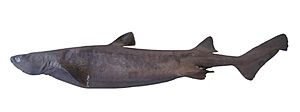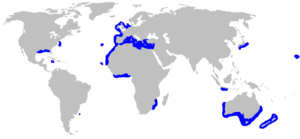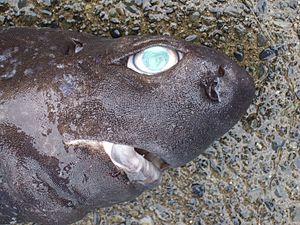Kitefin shark facts for kids
Quick facts for kids Kitefin shark |
|
|---|---|
 |
|
| Conservation status | |
| Scientific classification | |
| Genus: |
Dalatias
|
| Species: |
licha
|
 |
|
| Range of the kitefin shark | |
| Synonyms | |
|
Dalatias sparophagus* Rafinesque, 1810 * ambiguous synonym |
|
The kitefin shark (Dalatias licha), also called the seal shark, is a fascinating deep-sea shark. It belongs to a group of sharks known as squaliform sharks. You can find these sharks scattered across the world's oceans, usually living near the sea floor. They prefer depths of about 200 to 600 meters (650 to 2,000 feet).
This shark has a special trick: a very large liver filled with oil. This oil helps the shark float easily in the water. It means the kitefin shark can glide slowly without using much energy. It's also the biggest known animal that can glow in the dark! This special ability is called bioluminescence. The kitefin shark has a slim body, a short, blunt snout, big eyes, and thick lips. Its teeth are quite unique, with small, narrow teeth on top and large, triangular, saw-edged teeth on the bottom. Most kitefin sharks are about 1.0 to 1.4 meters (3 to 4.5 feet) long.
The kitefin shark is a powerful hunter that usually lives alone. It eats many different kinds of prey, from bony fishes and other sharks to squid and crabs. It can even take bites out of animals bigger than itself, much like its smaller cousin, the cookiecutter shark. Female kitefin sharks give birth to 10 to 14 live young. People fish for kitefin sharks for their meat, skin, and liver oil, especially in Portugal and Japan. Sadly, their slow reproduction makes them easy to overfish. Because of this, the International Union for Conservation of Nature (IUCN) lists them as a Vulnerable species.
Contents
Shark Names: Understanding Taxonomy
The kitefin shark was first described by a French naturalist named Pierre Joseph Bonnaterre in 1788. He called it Squalus licha. Later, it was placed in its own group, or genus, called Dalatias. The name Dalatias comes from a Greek word meaning "torch," possibly because of its glowing ability. The name licha comes from a French word for the shark, which means "glutton." Other common names for this shark include "black shark" and "darkie Charlie."
Shark Family Tree: Phylogeny and Evolution
Scientists study the "family tree" of sharks to understand how different species are related. This is called phylogeny. Studies show that the closest relatives of the kitefin shark are the cookiecutter sharks. They share many similar features in their teeth, bones, and muscles.
Scientists believe that kitefin sharks and cookiecutter sharks started to become different species around 65.5 million years ago. This happened after a big event that changed life on Earth, at the end of the Cretaceous period. The oldest known fossil teeth of the kitefin shark are about 43 to 37 million years old. These fossils have been found in places like New Zealand, Europe, Japan, and India.
What Does the Kitefin Shark Look Like?
The kitefin shark has a body that's a bit long and a very short, rounded snout. Its eyes are large, and it has big spiracles (small holes behind the eyes that help with breathing). Its lips are thick and have folds, but they aren't made for sucking.
This shark has different kinds of teeth in its upper and lower jaws. There are 16 to 21 rows of teeth on top. These upper teeth are small and pointy, curving slightly towards the corners of its mouth. The lower jaw has 17 to 20 rows of teeth. These lower teeth are very large, shaped like knives, and have saw-like edges. They fit together to form a continuous cutting surface.
The kitefin shark has two dorsal fins (fins on its back). The first one is a bit smaller than the second. Neither of these fins has spines. Its pectoral fins (side fins) are short and rounded. The caudal fin (tail fin) has a strong upper part with a notch near the tip, but the lower part is very small. The skin of the kitefin shark is covered in tiny, flat scales called dermal denticles. Each scale has a single ridge ending in a point.
The shark is usually a dark brown or gray color all over. Sometimes, it has faint black spots on its back. The edges of its fins can be white or see-through, and the tip of its tail fin is black. Most kitefin sharks are about 1.0 to 1.4 meters (3 to 4.5 feet) long and weigh around 8 kilograms (18 pounds). The longest one ever reported was about 1.6 meters (5.2 feet) long.
Glowing in the Dark: Bioluminescence
The kitefin shark is the largest known shark that can glow in the dark. This glow comes from special light-producing organs called photophores. These organs are mostly on its belly and point downwards. Scientists have two main ideas about why the kitefin shark glows. One idea is that it uses the light to see the sea floor while it hunts for food. The other idea is that it uses the light as a type of counter-illumination camouflage. This means the light from its belly matches the faint light coming from the surface, making it harder for prey below to see its outline.
Where Do Kitefin Sharks Live?
The kitefin shark lives in tropical and warm waters all around the world. However, its populations are spread out, meaning there isn't much mixing between them. You won't find this shark in the eastern Pacific or northern Indian Oceans.
In the northern Atlantic Ocean, it lives near the Georges Bank and in the northern Gulf of Mexico. It's also found from the North Sea down to Cameroon, including around the British Isles, in the Mediterranean Sea, and near Madeira and the Azores islands. In the Indian Ocean, it lives off South Africa and Mozambique. In the Pacific Ocean, you can find it near Japan, Java, Australia, New Zealand, and the Hawaiian Islands. There's also one record of it off southern Brazil in the southern Atlantic.
This shark is a deep-water species, meaning it lives far from shore. It's most commonly found at depths of 200 to 600 meters (650 to 2,000 feet). However, it has been caught as shallow as the surface and as deep as 1,800 meters (5,900 feet). Off the Azores, male and female sharks tend to live at different depths. Females are more common around 230 meters (750 feet), while males prefer depths of 412 to 448 meters (1,350 to 1,470 feet). The kitefin shark lives on the outer edges of continental shelves and the upper parts of continental slopes. It also lives around oceanic islands and seamounts (underwater mountains). Unlike other sharks in its family, it usually stays close to the sea floor, though sometimes it swims higher up in the water.
Life of a Kitefin Shark: Biology and Ecology
Kitefin sharks are usually found alone, but sometimes they form small groups. They are slow swimmers. Their large liver, filled with a light oil called squalene, helps them float easily. This means they can hover above the sea floor with very little effort.
Larger fish, other sharks, and even sperm whales hunt kitefin sharks. Not much is known about the parasites that affect this species.
What Do Kitefin Sharks Eat?
The kitefin shark is a strong and adaptable hunter of the deep sea. Its short, powerful jaws give it an incredibly strong bite. It mainly eats bony fishes, including deepwater smelts, viperfish, and lanternfish. But it also eats many other animals, such as skates, smaller sharks, squid, octopus, crabs, lobsters, and even polychaete worms.
Like the cookiecutter shark, the kitefin shark can also bite off chunks of flesh from animals much larger than itself, including other sharks and whales. The fact that it eats fast-swimming fish suggests that it might sometimes eat dead animals (scavenge) or have a special way to catch quick prey. In the Mediterranean Sea, bony fish are their most important food all year round.
Reproduction and Life Cycle
Kitefin sharks reproduce in a way called aplacental viviparous. This means the embryos develop inside the mother's uterus and get their food from a yolk sac, rather than a placenta. In the Mediterranean, they breed throughout the year, with more births happening in spring and fall. Females might rest for a year between pregnancies.
A female kitefin shark gives birth to 10 to 16 young at a time. Larger females tend to have more pups. The young sharks are born at a length of about 30 to 45 centimeters (12 to 18 inches), depending on where they live. Their gestation period (how long they are in the mother) might be as long as two years. Males become ready to reproduce when they are about 77 to 121 centimeters (2.5 to 4 feet) long. Females mature when they are about 117 to 159 centimeters (3.8 to 5.2 feet) long.
Kitefin Sharks and Humans
Kitefin sharks live so deep that they are not a danger to humans. However, their upper teeth have been found stuck in underwater fiber-optic cables.
Humans have used kitefin sharks for a long time. Their meat is eaten in places like the eastern Atlantic and Japan. Their liver oil is used in Portugal, Japan, and South Africa. The shark's skin can be made into a rough leather called shagreen, which is used for furniture and jewelry. It's also used to make a special Spanish polished leather called "boroso." In the western Atlantic, this shark doesn't have much commercial value.
Overfishing Concerns
As fishing expands into the deep sea, there are worries about deep-water sharks like the kitefin shark. These sharks grow and reproduce very slowly, which makes them very vulnerable to overfishing. A good example of this is what happened with the kitefin shark fishery off the Azores islands.
This fishery started in the early 1970s to get liver oil. In the early 1980s, more large fishing boats were added, leading to a peak catch of 937 tons in 1984. But after 1991, the number of kitefin sharks caught dropped sharply to less than 15 tons each year. This, along with a drop in the price of liver oil, made the fishery unprofitable by the end of the 1990s. Studies suggest that the shark population in the northeastern Atlantic had fallen to half of what it was before fishing started.
Most commercial catches of kitefin sharks happen off Portugal and Japan. They are often caught by accident (as bycatch) in bottom trawls (nets dragged along the bottom) and on hook-and-line. In 2000, Portugal reported catching 282 tons of kitefin shark bycatch, and 119 tons in 2003. In other parts of the northeastern Atlantic, this shark is rare. Surveys suggest that kitefin shark numbers west of the British Isles may have dropped by 94% since the 1970s.
In the Mediterranean Sea, kitefin sharks are also caught by accident in bottom trawls and gillnets. Even though they are usually thrown back alive, many can't return to the deep water and don't survive. The International Union for Conservation of Nature (IUCN) has listed the kitefin shark as a vulnerable species because its populations have clearly declined.
See also
- List of prehistoric cartilaginous fish





